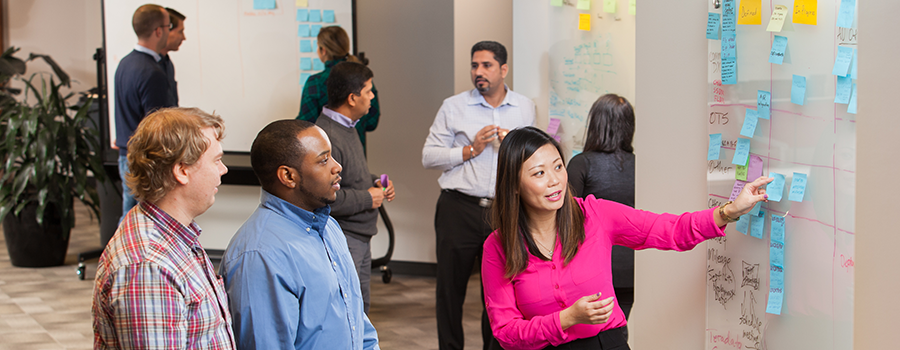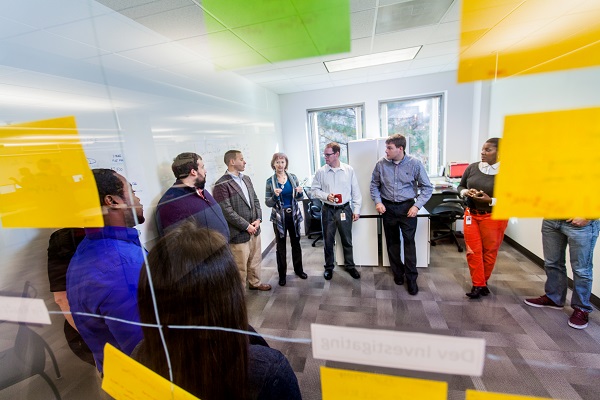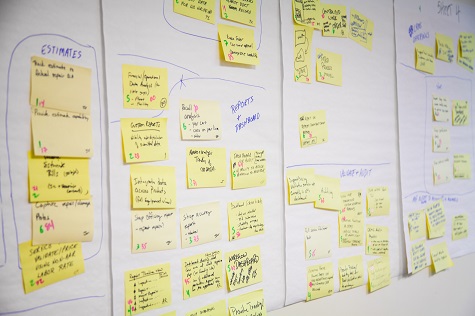
You know the process—blood, sweat, tears. Some tech projects just go down that way. You feel like you’re giving blood because you really want it to succeed. The sweat comes from all the hard work. Then tears. Most teams are disappointed when their project gets canceled. But this time they were tears of joy, because we knew we were doing something right.
And killing that project eight years ago signaled a breakthrough in the Railinc software development process.
We had already tried and failed once to apply the Agile software development methodology to one of our tech projects. While customers were indeed more engaged with us, it turned out that we had picked the wrong project. And we had an insufficient infrastructure in place to support it. And we had stretched our development team too thin. And the list goes on. It just wasn’t right.
But we tried again because we saw the opportunity. We could make products our customers would like better. We could lower our cost of doing business. We could transform our IT culture and become a more dynamic and highly productive organization. So the next time we tried it, we had the right project and the right people. We brought in Agile consultants to advise us. We had executive support and the infrastructure we needed. Our customers were on board and fully engaged.
Then, bam! It hit us. As our work progressed and we collaborated with our customers, the business team concluded that the product did not meet a viable market need.
We had worked so well with our customers—prioritizing needs, deploying iterations and assessing performance—that they quickly saw that the product was not right and wasn’t going to be right. So we killed it and transformed our business.
What Is Agile?
A group of software development methodologies based on iterative development, Agile enables product requirements and solutions to evolve through collaboration among self-organizing, cross-functional teams. Coined in 2001, the term refers to the Agile Manifesto, which espouses four principles:
-
Individuals and interactions over process and tools
-
Working software over comprehensive documentation
-
Customer collaboration over contract negotiation
-
Responding to change over following a plan
Unlike typical “waterfall” development, it has increased employee productivity, engaged employees and brought us closer to our customers. With Agile, customers become deeply involved with the product early in the development process.
sticky notes and white boards covered in ideas throughout our offices," said Jose Solera, Railinc's director of enterprise services and our resident Agile evangelist.

Based on customer input during the process, we immediately build relevant features that address their business needs. If a feature doesn't meet a need, we can fix it, throw it out or try something else, always improving the product as we develop it. Or maybe we just kill it because it doesn’t work. Customers feel empowered because of their involvement in the process. They feel valued because we listen to them. And they feel satisfied because they get what they want most, more quickly than they thought possible.
Agile also pleases our employees. They feel better about their jobs because the customer uses more of their work and values it. Plus their daily interaction with business representatives and end-users empowers them to innovate. Teams largely manage themselves, and teamwork improves as a result.
Adopting Agile Gave Us New Life
Few companies practiced Agile when we began considering it a decade ago. But Railinc needed a change. At the time, we were dragged down too often by problems like inadequate requirements, rigid schedules, buggy systems and the perception that our IT operation was just too slow. Like in any change in doctrine, some people felt threatened and others expressed skepticism that it would work. Something had to give.
We used external consultants to help us uphold the tenets of the doctrine. We carefully picked internal staff to propagate “the faith.” We put great deliberation into choosing our Agile pilot project to improve chances of success. We quietly converted development staff along the way to advance our cause one person at a time.
But killing that project gave us new life.
It enabled us to thoughtfully take on the challenge of changing our corporate culture and convincing customers to adopt Agile and its principles. The first several projects taught us much. We weren't well prepared early on, and that made customers uncomfortable. We learned, adjusted and improved. Now they become believers on Day 1 of every project.
Railinc Becomes a Leader in Agile
Almost 10 years later, we've gotten past the growing pains and learned how to do Agile at the enterprise level. Our people have grown to become Agile leaders recognized for their knowledge and expertise. Through our employees' hard work and commitment and our customers' willingness to collaborate, Agile has just become the way we get work done at Railinc.
Killing that project was one of the best things we've done at Railinc. Agile guides our work across the organization, from product development and infrastructure management to business and product planning. Our projects come in ahead of schedule and under budget, and deployments happen quicker and more often.

In 2015 alone, we will focus on a dozen critical industry projects that will lead to such outcomes as a multi-layered digital map of North America's busiest rail terminal; an industry capability to more quickly identify railcar component and equipment failure patterns; and the ability to assign mileage to railcars in real-time. And we have lots of internal IT projects, too, including the implementation of a rules process management system and the completion of a disaster recovery program. Agile will help us to deliver on all of these projects and provide valuable, consequential technology solutions for the freight rail industry.
But the proof is in the performance. Our customers appreciate what Agile has done for Railinc and our development process. We hear it in emails to our executive team and in conversations with customers. And our Net Promoter Score (NPS) reflects our success. The annual NPS survey asks one question: “How likely are you to recommend my company to someone you know?” Since 2010, our NPS has improved by 37 percent, and we’ve grown from 170 employees to almost 300 now. Our future shines brightly.
"The entire Railinc organization is focused on supporting our customers through the delivery of data," Solera said. "The focus of our leadership has been to make sure we deliver on that commitment."
And we do, thanks to Agile.
—Railinc Corporate Communications
